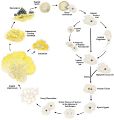Species
Physarum Policephalum is an eucaryotic organism which belongs to the class of Myxogastria. It passes a life cycle of morphologic phases, with the phase in which the multinucleate cells form a plasmodium (thin film, with visible branches) often being used for study purposes. This slime mold can be found in cool, humid, darker places, for example on rotten wood in the forest.
Images taken from: https://www.ctvnews.ca/sci-tech/strange-yellow-slime-mold-can-remember-where-it-left-food-study-says-1.5326525
https://knowledge.carolina.com/discipline/life-science/biology/the-slime-mold-physarum-polycephalum/
Growing of Physarum
To be able to use the plasmodium for projects or study purposes, bigger cultures of Physarum have to be grown.
Step 1: Preparing petri dishes:
Materials: Petri dishes, Erlenmeyer flask/pot, distilled water/tap water, powdered agar, scale, spoon, aluminium foil
The easiest gel to make is agar-agar-medium at a ratio of 1 to 100:
| Component | Quantity | Custom Quantity |
|---|---|---|
| water | 100 ml | x |
| agar agar | 1 g | x |
- Fill the needed amount of water either into a pot or the Erlenmeyer flask
- Weigh the needed amount of powdered agar (e.g. by using some aluminium foil as a dish)
- Stir the agar into the water
- Stir and heat the mixture until it's boiling (by using the stovetop or microwave) and take it off the heat before it boils over
- Pour the mixture into the petri dishes until they are max. halfway full, close the lids and let them cool down until the medium has solidified
Step 2: Preparing food for the slime mold
Since Physarum is capable of ingesting material by phagocytosis, it needs "food" to grow, if it's starved, it will escape.
A supply of oat flakes can be used as a source of food.
Newly bought oat flakes can be put into a sealed container (e.g. a glass bottle or a mason jar), but if you want to try to prevent future contamination as much as possible, the oat flakes can be sterilized:
Materials: Glass jars with lids, cotton wadding, aluminium foil, water, pressure cooker
- Prepare a jar with a lid by putting a hole into the lid and insert some cotton wadding tightly into the hole (the hole in the lid is very important, otherwise the jar might burst inside the pressure cooker)
- Fill some oat flakes into the jars, close the lid and put aluminium foil over the lid to prevent contamination later on (cover the lid completely)
- Pour enough water into the pressure cooker, but not so much that the glasses are floating (follow manual for guidance), place the glasses inside
- Close and lock the lid and wait until the needed temperature and pressure point are reached (121°C, 15 PSI)
- Reduce the at minimum heat at which it is possible for the water to keep boiling
- From that point on, wait about 50 minutes and ensure that the pressure of 15 PSI is kept throughout this time
- After that wait for the cooker to cool down on it's own and only then release the pressure to prevent it from boiling over
- Take out the jars, let them cool down and only open them under a flow hood with gloves and disinfected hands
Step 3: Starting a new culture
Materials: gloves, tweezers, bunsen burner, paper towels, 70%-alcohol, petri dish with agar-medium, oat flakes
- (put on the flow hood and disinfect the surface you are working on with alcohol, however the flow hood is not absolutely necessary )
- put on gloves
- spray a paper towel with alcohol and clean the tweezers, then hold them over the flame of the burner (doesn't have to be long) (and put them into the flow hood)
- disinfect your hands with alcohol before working with the slime mold
There are two ways for starting a new culture of Physarum
- Using a part of an already existing culture:
- From the existing culture take an oat flake (or multiple) with slime mold on it with the tweezers and place them in the middle of the new petri dish
- Place oat flakes as food in the petri dish around the flake with the mold
- To prevent future contamination the petri dish can be sealed with Parafilm
- Preserved Physarum comes dried on a filter paper inside a sealed bag
- Place the paper in the middle of the petri dish and put drops of water on the paper to reactivate the slime mold
- Place oat flakes around the paper
- Optionally the petri dish can be sealed with Parafilm
jjsjdajpda




